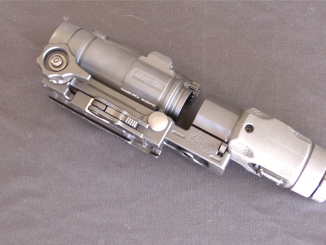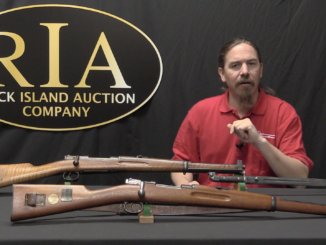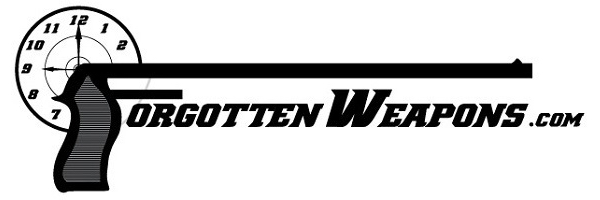Circa 1954, Sweden was starting to look for a new self-loading rifle to adopt for its infantry. The 6.5x55mm cartridge was a good round, but the idea of having ammunition compatibility with its neighbors was appealing, and NATO was standardizing on the new 7.62x51mm round. This rifle is an experimental conversion of a Ljungman to the NATO cartridge, which included replacing the original simple gas impingement system with a short-stroke piston. It’s unclear why that change was required given the successful Egyptian use of 8x57mm Mauser in the Ljungman system, but possibly it was needed in order to keep the gas block in the same place and reduce the cost of converting existing rifles should the system be adopted.
Related Articles

Accessories
Optics for Machine Guns: The Spuhr B.A.M.

Heavy MGs
Swedish Kulspruta m/36

Bolt Action Rifles

I find it interesting that the upper receiver cover on these rifles bears a striking resemblance to the cover on the Czech VZ-58. The writeups on the development of the VZ-58 always talk about the German influence on the design. I do wonder if someone also saw this class of Swedish rifles.
Couple of thoughts…
One, I think that “thing in the middle” of the piston spring might be one of two things, or maybe a bit of both: One, it might be that the designers wanted to reduce the amount of “spring flop” you get with long springs like that, or they wanted to use up some shorter springs they had laying around the prototype shop…
Maybe both.
My second thought is this: At some point, researchers in the future are going to be using this site and Ian’s work as source material. Given that, those researchers are going to be incredibly grateful if there is surrounding metadata on these videos telling them when and where the video was taken, the date, and all that other stuff that goes into “data provenance”. I mean, it’s great that Ian grabs the serial numbers and other markings, but… Someone is likely gonna want to know things like “Where the hell was that video taken, and whose collection did that weapon come out of…?”
It wouldn’t surprise me a bit if there isn’t some future controversy surrounding some esoteric video Ian has made, and people are going to be arguing over some lost artifact like they do the Amber Room… “Well, we know that Ian handled and videoed the wz.38M sometime in 2017 or 2016 at an auction house, but we don’t know where that specific specimen wound up… Records of the auction have been lost, and nobody now knows who bought the rifle or where it wound up…”
I mean, sure… The privacy of purchasers needs to be respected and all that, with regards to the auction house stuff and private collections, but with anything else, full identification details like specific museum collections and catalog numbers ought to be preserved somewhere in the metadata so that researchers in the future can go “Yeah, this was in the collection at Museum X, catalog #Y when Ian McCollum did a piece on it in 2019… From there, we stand a chance of finding it.”
I am not kidding when I say that Ian’s work is probably going to be a massive source for researchers in the potentially far-off and improbably distant future to us. “Digital archaeology” is going to be a thing, with people going back through preserved records and things that people downloaded locally and burned onto long-lived media. Including as much of the metadata now, as we are creating these things, would likely be a godsend to all involved.
You find it fascinating that future dabblers in details will, indeed, argue about details? Fascinating. Contentious people contend with one another. Not exactly tthe hottest ticket in town.
It’s a bit of a stretch to say that the Egyptian 7.9 x 57mm version, the Hakim, was “successful”. Most reviews of those I’ve seen or read agree that they’re a PITA to keep running.
In fact, unless the bolts holding the action to the stock are torqued just exactly right, the dumb things won’t “run” at all, not even as a straight-pull bolt-action.
The follow-on Rashid carbine in 7.62 x39mm was apparently concocted less as a sop to the Soviets than as an effort to get at least some use out of the tooling, i.e. a rifle for the reserves that more-or-less worked. But even it was a cranky SOB in service.
This experimental version of AG42B may have been a tacit admission by Ljungman and/or Karl Gustav that their original design wasn’t all it was cracked up to be.
clear ether
eon
I don’t have a lot of trigger time behind a Ljungman, but my impression was that the rifle was marginal with the 6.5 Swedish, and completely out to lunch with the Hakeem variant. When I was shooting them, I laid that down to the hinky-ass cheap ammo we were mostly shooting, and now that you mention this, I’m thinking maybe the design itself wasn’t quite what it was cracked up to be.
As with all things, your mileage may vary.
I can’t wait for Ian to go over that paratrooper version, though… That thing has intrigued me from the first time I saw a picture of it.
Some things are just cool, no matter how well they did or didn’t work in practice. The Ljungman rifles are in that category.
The only really nice rifle with a direct impingement action that I’ve experienced was the MAS49/56 I got to fire with French-issue ammo. Good rifle; it’s too bad it couldn’t have seen service in WWII with a realistic cartridge like the .280 British, or something equivalent.
If it does not work in practice maybe it is in the ‘coulda been cool’ category.
The predecessors of the MAS FSA 1949-56 of course was the model 1949 and 1944. The predecessor of those was actually the model 1940, which used the same flush-mauser style magazine loaded with five-round chargers as the MAS Mle. 1936 bolt-action rifle. That rifle could have been in service in WWII, with an excellent 7.5x54mm cartridge, but as it worked out, there were just 1/4 of a million bolt-action MAS Mle. 1936 rifles while most French troops were basically packing 5-shot Berthiers. Since I don’t read French original sources, I’m reliant on Jean Huon’s books in translation.
Since we are talking Ljungman self-loading rifles–a very accurate rifle, by the way, using the excellent 6.5x55mm Swedish Mauser cartridge–we should note that after WWII Sweden began to participate in UN missions. In fact, there were debates about sending troops–and not just medical personnel–to Korea in 1950. The decolonization of the Congo, on the other hand, did see some ground personnel dispatched. So 7.62x51mm was out of interoperability concerns with member states of the UN, and later still emblematic of Sweden being officially neutral, but secretly–or not so secretly–pro-NATO. Now the nation is in Nato of course.
Regarding the “300” marking seen at https://youtu.be/Iy9z8pnLwIA?t=217 if you look carefully you can in fact see what appears to be a dot (a period, or decimal place) stamped just to the left of the 300, so the idea that this marking represents the nominal bore diameter of .300 is plausible.
I find it strange that 1950s Swedes would use inch measurement system considering that since 1876 they use metric system and 7,62×51 NATO cartridge was referred to in metric values. If few examples could be inspected then it would be possible to determine if this value appears at all of them or differ for each one.
According to https://smallarmsreview.com/the-swedish-automatgevar-m-42-ljungman/
After a conversion to NATO caliber 7.62x51mm, some Ljungman systems served as ranging guns for the 90mm anti-tank gun Pv-1110 under the designation “Inskjutningsgevär 5110.” From 1949 on, Denmark tried to improve the Ag m/42 design, and the company Dansk Industri Syndikat A/S (DISA) produced various weapons in different calibers under the designation “Madsen/Ljungman.” After only about 50 test pieces, the project came to an end in 1955.
Was there any experience transferred between Danish and Sweden or vice versa w.r.t. improvements of said fire-arm type? How well Inskjutningsgevär 5110. worked in ranging role?